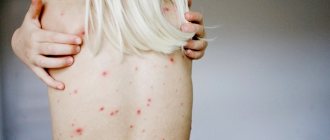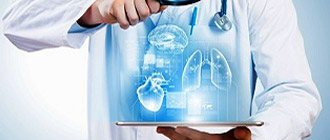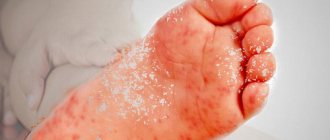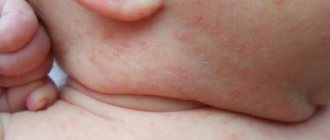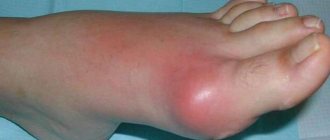December 5, 2020
Most infections are caused by streptococci and staphylococci. They live in the environment, inhabiting the skin, mucous membranes of the mouth, nose, and genitals. In 9–12% of cases, inflammation is provoked by corynebacteria, leprosy bacilli, tuberculosis, and campylobacter.
Healthy skin keeps germs out. This is prevented by the structure of the epidermis, the pH of sweat and sebum, and the antiseptic properties of the secretion of the sebaceous glands. When protection is violated, pustular rashes occur.
Types of rash and causes of its appearance
The content of the article
A rash is a visual change in the structure and color of the skin; it is characterized by redness, itching, peeling and even pain. The halo of the rash, despite its external integrity, consists of individual elements, which include:
- ulcers (defects on the surface of the epidermis caused by slowing down the regenerative processes in the upper layers of the skin);
- erosion (superficial epithelial defect without scar formation)
- papule (dense nodule located above the surface of the skin);
- vesicle (a fluid-filled capsule located in the upper layers of the epidermis);
- pustule (a cavity formation on the surface of the skin filled with pus);
- blister (an element on the surface of the skin caused by inflammation and swelling of the papillary dermis);
- nodes (dense, painless nodules on the skin);
- hemorrhages (subcutaneous hemorrhages caused by high permeability of the vascular walls);
- petechiae (pinpoint subcutaneous hemorrhages caused by capillary injury);
- ulcers (deeply located formations filled with pus).
Depending on the location of the skin rash, the source of the problem can be determined. In particular:
- Allergic reactions cause a rash on the hands and face;
- Infections are characterized by rashes on the torso (abdomen, back);
- STIs are localized on the genitals, inner thighs and skin around the anus;
- Stress weakens the immune system, so the rash is localized throughout the body (but, unlike allergies or rashes due to infections, the reaction to allergens and immunoglobulin will be negative)%;
- Problems of the gastrointestinal tract are expressed in the form of serious skin abnormalities (with ulcerative colitis - erythema nodosum (inflammation of the subcutaneous tissue and blood vessels in the form of nodes), with problems with the pancreas - atopic dermatitis, intestinal infections provoke pyoderma - ulcers on the skin);
- Rashes due to problems with blood or blood vessels appear on the abdomen and then spread throughout the body. It is characterized by the absence of itching.
What type of rash is typical for allergies?
Allergy skin rashes are not caused by an immune reaction of the blood to allergic elements. This is due to haptens - simple chemical compounds that are not immunogenic. But they tend to bind to the carrier protein. Attaching to a macromolecule, the newly formed complex synthesizes immunoglobulins. The body perceives it as foreign, causing an increase in the level of leukocytes. As a result, the skin becomes covered with red spots of different sizes and different locations.
An allergic rash is characterized by the following characteristics:
- It does not always cause itching and fever;
- Accompanied by swelling of the face, eyelids, runny nose;
- The area of the rash corresponds to the places where the skin comes into contact with the allergen (if you are allergic to jewelry - on the wrist or fingers, to deodorant - in the armpits, to cosmetics - on the eyelids or around the mouth);
- A blood test shows an increase in the number of eosinophils;
- The biochemical blood test remains unchanged.
The most common form of allergy rash is hives. In appearance, it resembles pink spots that appear on the skin after contact with nettles. Hives are a reaction to pollen, cosmetics, and dust. Often localized on the bends of the elbows, knees and wrists. Accompanied by severe itching and peeling of the skin.
Depending on the allergen, the rash has the following types:
- Allergy to food . It is an erythematous rash in the form of rough spots rising above the surface of the epidermis. A characteristic feature of food allergies is severe itching.
- Cold allergy . Occurs when exposed areas of skin come into contact with cold (air, water). Although cold does not directly provoke an allergic reaction, it is a trigger for an allergic reaction to improper functioning of the thyroid gland, spleen, etc. Cold allergies are accompanied by lacrimation, nasal discharge, as well as the appearance of whitish and pink, scratch-like spots on the skin, which disappear on their own after some time. If a person has ever had an allergy to cold, he needs to see a doctor to find out the true cause of the malfunction of the body.
- Allergy (atopic dermatitis) to dust/animal hair . It is often diagnosed in children. It manifests itself in the form of an itchy rash, accompanied by increased dryness of the skin. In some cases there are weeping ulcers. The simplest test to identify atopic dermatitis: take an ordinary school ruler and press on the area of the rash for 20 seconds. If a white streak remains on the skin after a few minutes, it is atopic dermatitis. If the skin has regained its previous shade, this is a rash of a different nature.
- Allergy to alcohol . Alcohol has a vasodilating effect. Accordingly, more substances, including toxic ones, are absorbed into the blood. The more components in an alcoholic drink, the stronger the allergy to it. The most “dangerous” drink is absinthe, which contains wormwood, anise, fennel, coriander, and lemon balm. The skin becomes covered with red spots, as if from burns. In chronic alcoholics who drink cheap wine every day, a red, weather-beaten face is a consequence of constant alcohol intoxication of the body. If such a reaction occurs in an ordinary person, he needs to find out the source of the allergy and consult a doctor. The biggest danger is Quincke's edema, when the lungs swell and the person dies within a few minutes.
There are 4 types of allergic rashes: food, contact, respiratory and respiratory. The biggest allergy sufferers are children. It should be remembered that not all products consumed by adults are suitable for children.
A child’s rash should not be ignored. The most dangerous is the rash caused by meningococcal infection. Outwardly, it resembles a food allergy, but at the same time the body temperature rises. It’s better to be on the safe side, and if your baby has any rash, you should consult a doctor.
Infectious rash: characteristic features and difference from allergic rashes
The distinctive features of an allergic rash are vesicles (capsules with liquid inside), papules (grain-like compactions) and pustules (bubbles with pus). An infectious rash has these symptoms.
Various infections and viruses entering the body damage, first of all, the mucous membrane, as well as the skin. Unlike an allergic rash, an infectious rash is always accompanied by an increase in body temperature.
Also characteristic signs of infection:
- body intoxication, vomiting, headache
- fast fatiguability
- phasing, spread of the rash to other parts of the body with each new day
- enlarged lymph nodes
- rashes look like papules, vesicles and pustules
- the skin dries out and flakes off.
The infection rash is not itchy, but touching it is painful. The causes of rashes are the following diseases:
- Herpes: depending on the type of virus, the skin of the face (lips) or the genitals (head of the penis, labia) are affected. The rash looks like blisters, which gradually open up and ulcers form in their place. Upon completion, a crust will form that should not be touched;
- Scabies: The causative agent is a microscopic mite that leaves tiny tunnels under the skin. Unbearable itching occurs;
- Chickenpox: The rash resembles a mosquito bite, filled with serous fluid. Vesicles spread throughout the body, including the scalp. The soles and palms remain intact;
- Scarlet fever: the rash looks like roseola - pinpoint pink spots of various shapes. After a few days, the rash fades and turns brownish. After the temperature normalizes, the skin peels and flakes. A characteristic feature is redness of the tongue and enlargement of the papillae;
- Measles: the rash looks like papules, which are localized on the inside of the cheeks and gums. The rash spreads from the neck down the back, lastly moving to the limbs. The mucous membrane of the eyes becomes inflamed;
- Rubella: the skin becomes covered with red spots, localized in the thighs and buttocks, and malaise is observed;
- Infectious mononucleosis: lymph nodes enlarge, adenoids swell. The rash is observed throughout the body, including on the roof of the mouth;
- Meningococcal infection: This is an extremely dangerous infection that can lead to the death or disability of a child. It is by the appearance of the rash that one can notice the symptoms of the disease on the first day of infection. A rash with meningococcal infection is a consequence of exposure to toxins caused by the activity of meningococcus, which increase vascular permeability. The rash is hemorrhagic in nature, that is, it looks like small hemorrhages. Mainly localized on the buttocks and limbs.
There is an effective test to distinguish meningococcal rash from other rashes. You need to take a glass, turn it over, press on the area of the rash and twist it a little until the skin around it turns white. If the skin turns pale at the site of the rash, then it is not a meningococcal infection. If the rash remains the same color, you should immediately call an ambulance.
Rash caused by diseases of the blood and blood vessels
A rash due to diseases of the blood or blood vessels is caused by damage to the walls of the capillaries, as a result of which petechiae - small bright red dots - appear on the surface of the skin. Unlike ordinary hemorrhages, a rash due to blood diseases does not change color when pressed. Other signs indicate the disease:
- joint pain (knees, ankles);
- black stools, diarrhea, sharp pain in the abdomen as if poisoned;
- the rash covers the entire body.
Diseases that cause hemorrhagic rash include:
Idiopathic thrombocytopenic purpura (Werlhof's disease) is a blood disease in which small arteries and capillaries are blocked by blood clots. Mainly found in children, especially newborns. The disease has autoimmune causes of unknown etymology. Those. Your own immune cells perceive platelets as a foreign body and attack them. The rash is painless, occurs as a reaction to the administration of any medication, and is localized at the injection site.
Hemoblastosis. This is a malignant tumor that occurs very often in childhood. The rash has several types:
- hemispheres of red-brown color, covered with a crust;
- blisters with serous fluid inside;
- rashes similar to bruises, both large in size and in the form of bloody dots that appear without any reason.
In all cases, the rash causes severe itching. Blood tests for hemoblastosis show a significant increase in the number of leukocytes due to decreased immunity. Hemoglobin drops, lymph nodes enlarge. Platelet counts drop and the child gets tired quickly. The main cause of rash in diseases of the blood or blood vessels is a decrease in the number of platelets and a disruption in the synthesis of proteins involved in blood clot formation. This rash also occurs when taking medications that thin the blood (Aspirin, Warfarin, Heparin).
Diabetic angiopathy. This is a violation of the vascular capacity of the lower extremities, provoked by type 1 and type 2 diabetes mellitus. Due to the disease, the walls of blood vessels become thinner and become fragile. This causes skin dystrophy. Ulcers and erosions appear on the skin.
Symptoms
The first signs of the disease appear almost immediately (from ten hours to a day from the moment of infection!). Symptoms of purulent tonsillitis first appear similar to the symptoms of ordinary tonsillitis. The patient tries to cure a sore throat by gargling, but such measures have no effect. Then the following symptoms appear:
- high body temperature (up to 40°C);
- “lump” in the throat, increasing pain in the throat: ranging from a slight soreness to a “pain” when swallowing;
- nausea, vomiting, diarrhea;
- enlarged lymph nodes, pain when pressing on them;
- tonsil hypertrophy;
- the appearance of purulent plaque or pustules on the surface of the tonsils;
- pronounced intoxication of the body - the patient loses appetite, feels weak and lethargic.
Patients need to remember the first and main rule: it is necessary to treat purulent sore throat immediately: the sooner you start treating the disease, the faster the recovery will come, and the risk of developing pathologies will be minimized.
Rash caused by digestive problems
The condition of the skin largely depends on the functioning of the internal organs. Using a map of rashes on the face, you can determine which organs have problems.
- pimples on the forehead indicate problems with the intestines;
- a rash along the hairline indicates problems with the gallbladder;
- pimples on the bridge of the nose - liver problems;
- ulcers on the temples - problems with the spleen;
- rashes above the lip - disruption of intestinal function;
- pimples on the nose - heart disease or endocrine disorders;
- rash on the chin - gynecological problems.
Pustules on the face: what to do?
Since pustules indicate an inflammatory process, most cosmetic procedures are contraindicated for them. What remains is drug treatment and home care. Here are some guidelines to follow:
- Gentle care. If there are an abundance of pustules, it is necessary to take more careful care of the skin so as not to damage them. It is necessary to discard the idea of squeezing out acne elements. This is fraught with the spread of inflammation and aggravation of the clinical picture.
- Exclusion of alcohol-containing products from care. Attempting to dry acne will not be beneficial. The skin will respond with even greater sebum production and hyperkeratinization. And these are already two links in the mechanism of acne formation.
- Nutrition correction. Since the appearance of acne may be associated with the consumption of certain products, for example, dairy. There is evidence that if there is an excess of sugar and fat in the diet, as well as eating on the go, it can provoke an exacerbation of acne.60
- Light makeup. Pustular rashes are very difficult to hide with cosmetics. As a rule, applying a generous amount of foundation creates a mask effect. The face looks unnatural and the skin cannot breathe. As a result, the pores only become more clogged. Makeup for acne is acceptable, but it is better to keep it light. In the evening, it must be carefully removed, for example, with micellar water or milk.
- Refusal of traditional methods of treatment. Do not try to prepare masks or creams yourself. Firstly, the use of multi-component compositions prepared by yourself can provoke irritation, itching, redness, and an allergic reaction. Secondly, you will waste time and may make the problem worse.
You can get rid of pustular rashes only by using medications prescribed by a dermatologist.
Rashes due to liver diseases
In the early stages of liver disease, they practically do not manifest themselves at all. The earliest symptom is specific skin rashes. They are caused by an increase in the amount of bile acid in the blood, which causes general intoxication of the body. The skin takes on a yellowish tint.
With cholestasis (blockage of the bile ducts), the rash is localized on the feet and palms, looking like marks from a burn. With cirrhosis, liver cells die and the whole body becomes covered with spots. Parasitic liver diseases cause rashes resembling hives. They are localized in the lumbar region and abdomen.
Also characteristic is a combination of rash and spider veins, which cause severe itching, which intensifies at night. Taking antihistamines (allergy medications) does not provide relief. Increased bilirubin gives the skin a yellowish tint.
Treatment of bacterial skin infections
It should start from the early stages and be carried out under the supervision of a specialist. In some cases, local treatment with antibacterial ointments and wiping with antiseptics is sufficient. Widespread rashes, deep pyoderma, require the prescription of systemic antibiotics. In chronic cases, the doctor may recommend autohemotherapy and immune drugs.
Surgical treatment is carried out if the abscess does not open on its own or if a rough scar must be avoided. Laser coagulation and physiotherapy are used to restore tissue.
It is important to identify and treat concomitant diseases, eliminate adverse external effects on the skin, and select nutrition.
Rashes due to intestinal diseases
If the contents of the intestines are poorly removed from the body, then some of the toxins will begin to penetrate into the blood. The body begins to get rid of poisons itself through the excretory system. Because of this, the condition of the skin worsens, and it becomes characteristic of:
- increased fat content
- dull complexion
- acne, not only on the face, but also on the back, stomach, chest
- noticeable “black dots” similar to volcanic craters
- skin becomes dry and dehydrated
- After acne heals, scars remain.
After the New Year holidays, many people note a deterioration in their skin condition and notice minor rashes that go away on their own. They are associated with contamination of the body with toxins caused by eating large amounts of heavy food.
Pustules are small pustules on the face
A pustule is an inflammatory acne element, inside of which there is a cavity filled with purulent contents. Its size can reach 10 mm. The shape can be cone-shaped, flat, hemispherical. A pustule can form as an independent element or from a papule. When pustules appear on the face, the cause must be sought in the inflammatory process occurring in the skin.
You can tell that a pustule has formed by looking at the white head of the pimple*. Its contents are usually white, yellowish, and sometimes greenish. The contents of the pustule may dry out, a crust will form on top of it, the fall of which may lead to the appearance of a hyperpigmentation spot.
If even small pustules appear on the face, it is necessary to take action, as they can turn into indurative acne. With this form of acne, inflammation spreads into the deeper layers of the skin. Resolution of such acneous elements may leave behind atrophic scars.32
Nervous rash
Stress and nervous tension often cause skin rashes. Under the influence of a stressful situation, the immune system is suppressed. The body spends its resources to maintain the normal state of internal organs. For this reason, previously hidden diseases worsen. Also, weakened immunity provokes urticaria - a small rash similar to the reaction of the epidermis to the touch of nettles. This pathology is otherwise called nervous eczema. It, unlike a normal allergic reaction, is accompanied by the following symptoms:
- severe itching that is not relieved by antihistamines
- pulse quickens, hand tremors are felt
- restless sleep, night sweats
- panic attacks, feelings of anxiety and danger
- swelling of the face and limbs.
Typically, nervous eczema occurs after a traumatic situation or severe stress. Treating skin rashes with creams or medications does not help. Improvement comes only after the life situation normalizes. Itchy urticaria due to nervousness can be soothed by baths with sea salt, which also have a good effect on the nervous system.
